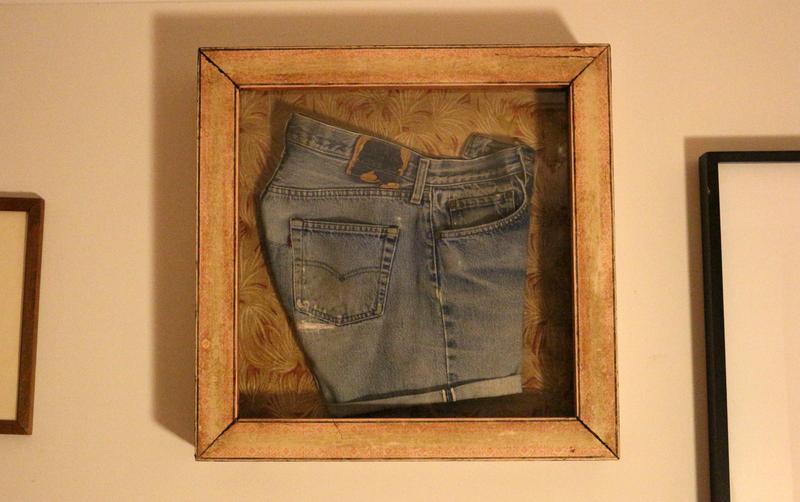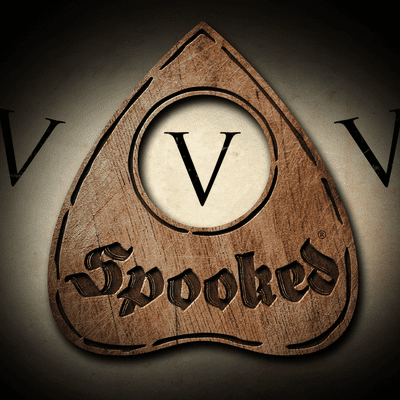The Case of the Cutoffs

KATHY: Tobin?
TOBIN: Yes?
KATHY: You know how I don’t like things that I have to do every day? Such as….eating, sleeping.
[TOBIN LAUGHS]
KATHY: So dressing up, or just putting clothes on, as I call it, is a daily annoyance for me, since I was a child.
[MUSIC STARTS]
KATHY: When I was in middle school, our school decided to have a vote on whether or not we were going to have uniforms and I secretly was like: “Yes!”
TOBIN: You’re like, “Give it to me.”
KATHY: So, I took home the little info sheet and it had a little like, voting thing at the bottom of it...and I bring it back and I had written down a “yes” vote for uniforms and I pass it in with everybody else and people saw my answer and I guess, I don’t know, everybody else didn’t want uniforms?!
[TOBIN LAUGHS]
KATHY: Which I didn’t understand!
TOBIN: So, were they like “Kathy, what the hell!”?
KATHY: They were!
TOBIN: And what did you say?
[MUSIC STOPS]
KATHY: ...My mom gave me twenty bucks to vote ‘yes’ so I did.
[TOBIN LAUGHS]
TOBIN: Classic, Kathy! Throwing your mom under the bus!
KATHY: I mean, it’s the least she can do.
TOBIN: Yeah.
[THEME MUSIC BEGINS]
VOX 1: From WNYC Studios, this is Nancy.
VOX 2: With your hosts, Tobin Low and Kathy Tu.
[THEME MUSIC ENDS]
KATHY: Tobin.
TOBIN: Kathy.
KATHY: Today we have, in the studio with us, radio producer friend: Ben Riskin.
TOBIN: Hi, Ben.
BEN: Hello!
TOBIN: How do we all know each other?
BEN: I think just through like gay radio circles and...general homosexuality.
TOBIN: Yeah, yeah, yeah, yeah. We met at the meeting.
BEN: Yeah, absolutely. The annual meeting. Are you going this year?
TOBIN: I don’t know. I mean, I got the invite but I’m like kind of busy that night.
BEN: Yeah, but the miles?
TOBIN: Yeah, it’s good, it’s good. But anyway, why have you joined us today?
BEN: I...have a mystery.
TOBIN: Ooo!
KATHY: Tell us more.
BEN: So, this mystery has everything. It’s has sex. It has daddies. It has denim. And, it has librarians.
TOBIN: Oh, I’m in. Ben, take it away.
BEN: Gladly.
[MUSIC STARTS]
BEN: On the wall of my apartment, I’ve got a two-foot by two-foot wooden shadow box. In this box, there is a pair of denim cutoff shorts. Levis, to be specific. I’ve owned the shorts for almost six years… I consider them one of my most treasured possessions — and they’re a great conversation piece when people come over to my apartment. But they’re also a mystery. I know nothing about the shorts, or how they came to live in a shadowbox.
BEN: I found them when I was visiting my hometown of Chicago in 2013. I was at a thrift store called the Brown Elephant, on Halsted Street. For a long time, the Brown Elephant kind of anchored Boystown — the gay neighborhood in Chicago. I was with a friend when we came across the shorts in the housewares section and I immediately felt like they were special — they didn’t belong in thrift store next to ceramic ashtrays and vintage bookcases. So, I bought the shadowbox and had it shipped back to New York, where I hung it on the wall of my apartment.
[MUSIC STOPS]
BEN: Over the years, I’ve made up a pretty elaborate backstory for the shorts… I believe that these are GAY shorts. One, they’re definitely men's shorts. Two, they are VERY short. They have – max — three to four inch inseam. Cut offs in the most classic sense — and a lot was cut off. And three, there's this iron pressed cuff that is very fastidious. The precision of a gay. In conclusion, these shorts have homosexual tendencies.
BEN: Being that they are carefully mounted in a shadowbox, I’ve always imagined the shorts as a memorial. In my mind, the memorial hung in a bar somewhere. Like whoever wore the shorts was a barback or a regular and they wore these shorts every day and everyone knew them because they had some iconic Chicago ass or legs. So when they died, you know, these cut-offs were mounted and displayed as a memorial to them.
BEN: I also believe these were the shorts of a gay man in the 1980s. They have that cutoff and combat boot style you don’t get much after the 80s and early 90s. And being that they are a gay man’s shorts from the 1980s, I’ve always imagined the owner died at a young age from AIDS.
BEN: This is a loaded theory, I know. But I grew up in the 90s and came out when I was 13 years old. The only representations of gay men were those dying of AIDS. I was terrified that the same would happen to me. So much so that I created all these illogical rules for having sex and didn’t even have anal sex until I was in my mid-20s. I only recently began unpacking all of these fears and feelings. But in the meantime, I think I kind of just attached them to the shorts.
[MUSIC STARTS]
BEN: So, for a long time, I just had this theory and didn’t worry about the truth. But I recently turned 35 and bought my first apartment. Because it’s in New York City, it’s only 270 square feet. Which is smaller than most of the houses on Tiny House Hunters. There were some painful decisions to make, like, what to keep, and what to discard. And when I was deciding to keep the shorts, it felt like… if doesn’t have a history, I’m not sure it sparks joy for me.
BEN: I really firmly believe that the shorts are a piece of gay history. But what the fuck do I know? I have absolutely nothing to back up my theory but some cutoffs in a box. So decided to go on a search for the truth.
[MUSIC STOPS]
BEN: The first fact I needed to nail down was when these shorts lived. Because if I was wrong about the age of the shorts, then the whole theory was wrong. So, I reached out to someone who literally studies Levis for a living…
TRACEY: My name is Tracey Panek. I'm the historian for Levi Strauss and Company.
BEN: I’m so excited we were put in touch, I have a million questions. 90% are them are how do I become a Levi’s Historian and 10% of them are about these shorts.
TRACEY: Oh okay, then I can handle that.
BEN: Because Tracey lives in San Francisco, where Levi’s is based, she couldn’t examine the shorts in person. So she asked me to take some photos and send them to her… but in order to do that, I had to take the shorts out of the shadowbox.
BEN: All right, so I am touching the shorts. The capital S-shorts right now.
TRACEY: Oh, okay.
BEN: And this is the first time I’ve ever touched them. Like, they’ve never been out of the shadowbox and it’s a little awe-inspiring for me. What can you tell me based on the pictures?
[VOICE FADES OUT]
BEN: It was a nerve-wracking moment. It felt both forbidden and exciting to be touching something that someone had so carefully put behind glass… But from the photos, Tracey was able to tell me a few things about the shorts…
TRACEY: Well first of all, I can tell you that what we’re looking at is a pair of 501 blue jeans, and they’re my favorite Levi’s to talk about because they are the origins of blue jeans. {DUCK AUDIO UNDER TRACKING}
BEN: Tracey was also interested in the patch that had been really nicely sewn into the butt, and that previously-mentioned fastidious cuff on the bottom.
TRACEY: So clearly this was a pair well-worn, worn outdoors, worn and loved and kept in a way that's expressing their, their importance in this person's life.
BEN: Tracey also had me look for specific markings… which told her where the shorts had been manufactured….
TRACEY: in El Paso, Texas...
BEN: FINALLY, from a number — 52 — stamped on the back of the button, she was to tell me WHEN these shorts lived…
TRACEY: My best guess is that these pair come from the 1980s...
BEN: I WAS RIGHT. I LOVE BEING RIGHT. Some 80’s queen had really, really loved these shorts and I knew it all along. These shorts had lived a life, and most importantly, that life had been in the 80s.
[MUSIC STARTS]
BEN: So I knew the date … and how well loved they were… but Tracey couldn’t tell me much about who might have worn them.
BEN: What do you imagine the history might be for these?
TRACEY: There's such great connections with Levi's with denim and blue jeans when it comes to not only free expression and your sexuality but also about politics and being kind of a pant that is a bit rebellious. And what I mean by that is...
BEN: Tracey wasn’t ready to out the shorts. And I needed someone who was. I needed some evidence that these were part of gay history. So I turned to a different kind of historian…
SUKIE: Yes, well my actual name is Saint Sukie de la Croix. I am a saint, a saint but no angel. I can tell you that.
BEN: Sukie is a historian who specializes in Chicago gay nightlife ... He has this wildly in depth knowledge of the gay bars in Chicago from the turn of the century all the way through the 90s. He wrote a book about them… called Chicago Whispers, which is the gayest book name. Honestly I was kind of hoping he’d just be like…”OH THE SHORTS! Of course I know about them … let me tell you about Chris Cutoffs and his famous shorts.” But Sukie didn’t have any names for me. He did, however, rule out one possible suspect.
SUKIE: No, they’re not mine. No, I’ve never had the legs for them.
BEN: Sukie didn’t know who the shorts belonged to, but he had some thoughts on my search.
SUKIE: Are you getting a DNA test?
BEN: [LAUGHING] We haven't actually thought of that.
SUKIE: I watch too much Law and Order.
BEN: 23andMe isn’t a Nancy sponsor, so we couldn’t get a DNA test. But all jokes aside, Sukie did have a lead. He thought I should talk to some of the guys who were a part of the original Chicago leather scene.
SUKIE: Because they used to, I mean now you have, well not so much anymore, but in the last decades you have leather bars. But way back, you had leather and levi’s bars.
BEN: I had no idea…
SUKIE: Oh it could have been on the wall at one of those.
BEN: WHO KNEW?
[MUSIC]
BEN: I’ve been to my fair share of leather bars, but I didn’t realize the denim itself had place in history. This was a fucking lead! If it was Leather and Levis, it would make sense for someone in that scene to really, really love their Levis… so much so that when they died… they were framed as a memorial. Maybe even framed... and put on the wall of a local bar.
[MUSIC]
BEN: So with that clue … it seemed like a good time to head to Chicago to talk to some people in the know …And I enlisted FORMER Nancy producer Matt Collette to join me in the search… it began with searching for the shorts at the O’Hare baggage claim…
MATT: So, what are we looking for?
BEN: Oh, we’re looking for…it’s a box wrapped in bubble wrap in a box...and then it’s gonna be in a bag...
MATT: There it is!...
KATHY: That’s after the break.
TOBIN: You’re listening to Nancy.
[MUSIC OUT]
[MIDROLL]
[MUSIC]
BEN: Matt and I arrived in Chicago, shorts in hand, on a Thursday morning. Saint Sukie de la Croix had given us a list of leather bars, but most were closed for good and it was a bit early to hit up the ones that had survived. So we started our search for clues at another local leather establishment…
BEN: This used to be a synagogue.
MATT: Oh can you tell just from looking at it?
BEN: No, I read it on the website…
MATT: Oh! Right.
BEN: It’s certainly not a synagogue anymore. Gary Wasdin met us at the door...
GARY: I’m the executive director of the leather archives and museum.
BEN: Gary is tall, bald and has a big beard and broad shoulders …. He describes himself as Daddy. I would also describe him as one.
GARY: You know, I spent my whole life kind of keeping my professional life and personal life separate, and making sure I was Gary the library director, or I was Gary the leather man. And here I can just be Gary...I can be that awesome librarian and also that big leather daddy bear that’s running this place.
BEN: The Leather Archives and Museum is a collection of pictures, clothing, and gear from the leather scene in Chicago and across the Midwest. Gary offered to give us a quick tour of the museum. We started in what would have been the main room of the temple… a medium-sized room with high ceilings, stadium seating, and some very eye-catching artwork From floor to ceiling, the walls were covered in massive, wooden Tom-of-Finland-style murals showing leather daddies with huge dicks and big asses in all sorts of compromising positions. Gary explained that the murals used to hang at a bar called The Gold Coast which was the center of Chicago’s leather scene for nearly three decades until it closed in 1987.
GARY: So one of the things about this art, it was sort of there for you know stimulation purposes in the same way you have videos today. A lot of these murals, quite frankly, are saturated with cum. [Laughing] People go and look and wonder what’s all over this thing?! It’s like, well, let me tell you.
BEN: A black light night in this room is a totally different experience.
GARY: That’s what it was! I mean it was there to get people hot and it was effective. It did its job.
BEN: Remember when I mentioned that teenage me had all those illogical rules about sex? The overt sexuality on display in this room was the kind of the thing that *terrified* me. I was so afraid that if I really embraced my sexuality and had intimate or vulnerable relationships with gay men, I would surely die of AIDS. Not only is this not true, it’s not at all reflected in what we saw in the museum.
MATT: "The Last Supper in a gay leather bar with Judas giving Christ the finger."
BEN: This is incredible.
BEN: Gary walked us through all these positive, life-affirming displays about different leather scenes in the midwest. Leather families and groups of friends, vests covered in patches and pins, and guys in denim outfits with chaps and cowboy hats. A community of people - friends, lovers, and strangers - tied together by sexuality and intimacy. They had helped each other live before, through, and after an epidemic. It was a life that the owner of the shorts could have lived.
BEN: One thing Gary talked about was the ceremonial elements of the Leather Scene. Like passing down an heirloom in a birth family, there’s a tradition of gifting leather gear to others in your chosen family. This kind of tradition helped reinforce the bonds within leather families and the larger leather community.
GARY: God damn you put that leather on and you own the place. I mean it's that power, you sort of command a kind of respect from people and people look at you and you know they're making associations and there's you know there's sex, there's power, there's energy, there's all this stuff that goes with it.
BEN: Gary was talking about leather gear… but it made me think of the shorts. Maybe they were specifically chosen for the owner! A gift from someone that mattered. But still... who had put them in a shadowbox? Gary agreed with my theory that the shorts could had hung in a leather bar as a memorial … and he wanted to help us find the bar they might have hung in. Most of the leather and levis bars are closed now. But the museum’s archive is filled with photos of them.
BEN: I’m so excited to like, dive into shorts theories.
BEN: Down in the basement… Gary introduce us to Mel, one of the museum’s archivists, who was already busy searching for clues about the shorts. Sitting on her desk was a slim white box of 4x6 photos with worn edges.
MEL: I have three boxes. Um, they’re rodeo riders albums. Rodeo Riders was a leather/levis club, and they photographed every event in every bar from the late 70s to the 90s. So I went through and I looked through all the walls in all the bars I could find...
BEN: It’s awesome. We’re looking at this picture and to describe the picture it’s like, it’s, you know, four guys wearing kind of you know denim vests with pins and um you know uh uh chaps...but behind them on the wall, it’s like cowboy hats and ephemera and its exactly the type of wall I’m imag- I’ve always imagined the shorts hanging on. And like it feels really exciting to see a wall where I’m like it could be on that wall! That is like...that is really fulfilling to see!
BEN: As exciting as it was to flip through the photos…we didn’t find the shorts in any of them. Still, Gary was confident the shorts were important... and that I’d track down the story.
GARY: And then you’ll have to figure out, is the real history or the created history the more interesting story? And which one will you tell going forward?
[MUSIC]
BEN: So after a quick pit stop in the cum-stained mural room, we left the archive without any definitive proof. I was about ready for a nap, but Matt gave me hope that we might find someone who had been a part of the leather and levis world and knew something about the shorts. So I picked up the shadowbox, and we hit the leather bars in the neighborhood…
BEN: Uh, we are coming here from the Leather Archives and Gary suggested we try to…
BARTENDER: I wouldn’t know how to help you...I’ve got customers going right now and stuff.
VOICE 1: I wouldn’t even have a clue...
BEN: Have you ever seen anything like this? I’m not sure how long you’ve been in Chicago…
VOICE 1: My whole life…
BEN: Have you ever seen in the bar, or something like this…
VOICE 1: Hanging in the bar? No.
VOICE 2: I was thinking if you went to like Little Jim’s or something like that...
BEN: Little Jim’s?
VOICE 2: It’s on Halsted and Cornelia…
[MUSIC FADE OUT UNDER NEXT BIT OF TRACKING]
BEN: Halsted… just down the street from where I had bought the shorts … Little Jim’s is one of those bars that seems like it’s never changed. The average age of the patrons was around 70… and they were just lined up along the bar passing time. We felt very out of place, even without the radio equipment. But as soon as we asked about the shorts… this one guy immediately perked up.
VOICE 3: My first partner, before he died, we used to live in Cleveland and had a pair of jeans hanging on the wall. We belonged to the Leather Stallions, which was a leather club in Cleveland. And we hung all of our run pins - you know what a run is? - on these jeans that hung on the wall. So it was a reminder of oh yeah we went to this run, we were at that run. So it could be a reminder of a loved one who passed or just their own. They wanted something, ‘oh yeah I wore those in the 70s’
BEN: So, maybe the shorts weren’t a memorial at all… maybe they were just someone’s way of remembering a fun time in their life… I could almost see that. But not for these shorts, I just didn’t want to believe it. At a bar called Touche, the owner, had a different — more amenable — theory.
DAVID: It could simply be that somebody had a partner that he lost and it was maybe their favorite article of clothing and it was kind of a remembrance to them. Since there was no name to it or anything like that, I think it’s very personal, not so much that it was something about somebody else as much as it was for them.
BEN: Yeah, like there’s no plaque. Yeah, if this was at a bar or something, you’d get a plaque...
DAVID: Well that’s just it. If it was a significance of trying to recognize somebody for who they were as somebody special or whatever, for the world to know. I could see this more as like, this belonged to somebody that was special to me and it’s my way of remembering them. And I think that’s really cool.
BEN: A plaque.
[MUSIC]
BEN: I never thought about a plaque. But of course, if it were a public memorial of some sort, it seems likely that there would be a plaque — something letting the public know what the box was all about. Without one, it would make more sense for the shorts to be a private memorial.
[MUSIC running under tracking]
BEN: So, I was left with three possible theories: My original idea, that the shorts were some kind of public monument to a premature death… like the AIDS quilt. A second theory that they were an untethered reminder of fun times.….. and finally that they were a private memorial… a deeply intimate remembrance of another person’s life.
BEN: I always thought the shorts were a public tribute because the box was so big and garish, and you just don’t walk into a lot of homes featuring a pair of shorts in a shadowbox. But the evidence was starting to mount up in favor of these being a more private memorial. We’d been to the remaining leather and levis bars. No shorts. We’d looked through pictures of closed leather and levis bars. No shorts. We talked to a local bar historian with his own archive of photos and he’d never seen the shorts. On top of that, there was no plaque or anything on the shadowbox identifying the shorts and their owner. And... I found the shorts at the Brown Elephant. A thrift store in Boystown where a lot of gay people’s estates end up when they die.
BEN: There was one more person I wanted to speak with. Ron Ehemann. Originally, I was hoping to hear more about the Chicago leather scene. Ron’s partner, Chuck, had owned The Gold Coast, that bar that was the birthplace of Chicago’s leather and levis scene. But Ron was in a unique place to weigh in on the private memorial theory. I met Ron at his apartment. He moved in after Chuck died. The apartment is full of artifacts calling back to specific moments in their life together.
RON: Everything in the room and throughout the whole apartment is stuff that the family collected from our travels over the years. I think the the big dragon mirror is something that Chuck had when I met him and I think the steer horns...he had most everything else we collected from travelers or...I mean there's a story behind everything
BEN: Talking to Ron, I started to think about all the things he had collected over the course of his and Chuck’s relationship…what would happen to them when he wasn’t there to tell their story? Would they be treated like heirlooms and cared for as sacred reminders of gay history? Or would they be shipped off to a thrift store and abandoned in the housewares section?
[MUSIC]
BEN: To that end, what would happen to the shorts if I didn’t keep them. There aren’t a lot of institutional keepers of gay history. So many of our artifacts are only preserved if we do the preserving. And the shorts...well, I firmly believe they are an artifact of gay history. So I feel responsible for carrying that history forward. They’re an heirloom, gifted to me anonymously by my chosen family.
Ron: I mean it’s possible that somebody, hey, we’re decorating a bar so let’s get some iconic things, and frame them and throw them up on the walls but somehow this doesn’t feel like that to me. It feels like this particularly piece had great meaning to the person who created it. And it’s probably invested with a lot and you may be...that’s what you feel….you know. And you’re just taking it on your own journey because of that. But if it didn’t have a lot of meaning it certainly does now!
[MUSIC COMES IN POST, FADES INTO DISTANCE UNDER CHICAGO]
BEN: I left Chicago without learning who owned the shorts… Which is not to say that I’m giving up the search.
[MUSIC BEAT] PHONE RINGING
BEN: Before I head back to New York, a voicemail arrives from a well-known custom framing shop around the corner from Ron’s house.
[PLAYFUL MUSIC STARTS UNDERNEATH VOICEMAIL]
TODD: This is uh Todd Mack. Um...I’ll tell you what I know. Um that frame job...um...is definitely one of a kind.
BEN: He says there’s no frame like this on the market, so somebody must have made it special.
TODD: So that’s one thing. The other thing is, it’s been years, but I do remember a pair of shorts coming through.
BEN: But, unfortunately, that’s where it ends. He doesn’t have anything else to tell me.
TODD: But, feel free to call me…
[MUSIC]
BEN: So...the search continues. Maybe one day I’ll find out who these shorts belong to. But for now, they are safe...they are hanging on the wall of my apartment surrounded by pictures of my family, art, and gay ephemera. Like Gary said, when people ask about them, I have to choose between the real and the created history. But after the search, the two have kind of blended together. And I couldn’t be happier.
[MUSIC BEAT AND FADE OUT]
TOBIN: That was producer Ben Riskin based in New York City. And Matt Collette helped produce this episode.
[CREDITS MUSIC]
TOBIN: And that is our show! It is credits time.
KATHY: Producer...
TOBIN: Alice Wilder!
KATHY: Production fellow…
TOBIN: Temi Fagbenle!
KATHY: Sound designers...
TOBIN: Jeremy Bloom and Ania Grzesik!
KATHY: Editor…
TOBIN: Jenny Lawton and Stephanie Joyce!
KATHY: Executive producer…
TOBIN: Paula Szuchman!
KATHY: I’m Kathy Tu.
TOBIN: And, I’m Tobin Low.
KATHY: And Nancy is a production of WNYC Studios!
Copyright © 2019 New York Public Radio. All rights reserved. Visit our website terms of use at www.wnyc.org for further information. New York Public Radio transcripts are created on a rush deadline, often by contractors. This text may not be in its final form and may be updated or revised in the future. Accuracy and availability may vary. The authoritative record of New York Public Radio’s programming is the audio record.





